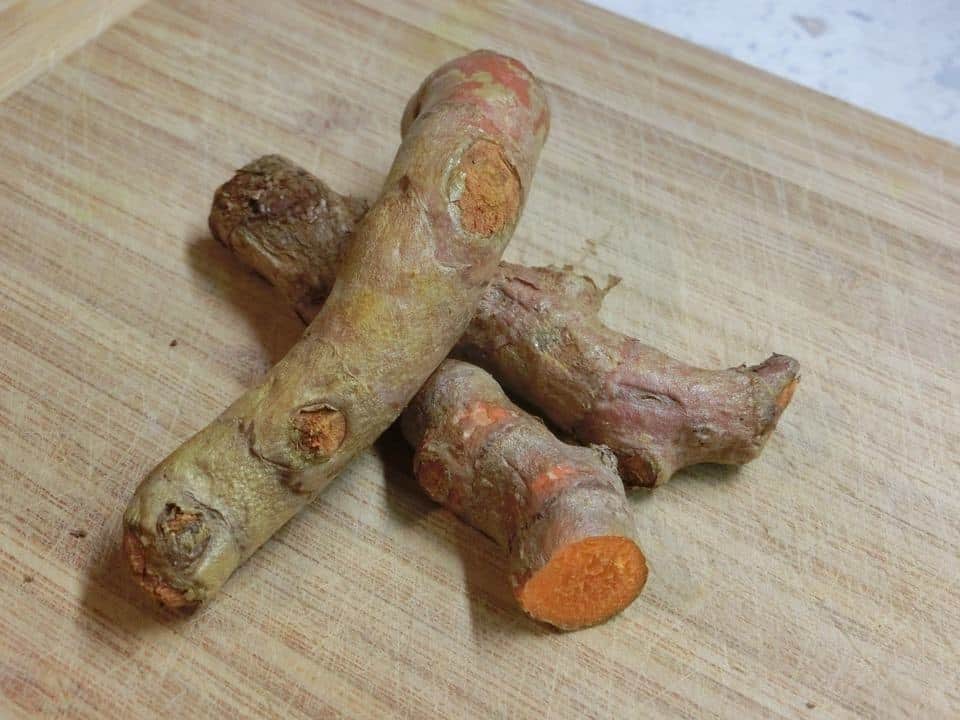What is Turmeric?
Turmeric is a perennial plant belonging to the ginger family. From the main plant, it sends out multiple roots and shoots underground (called rhizomes). These roots store starches and proteins which help the plant survive the winter underground. In addition, these stems allow the plant to reproduce asexually and create another parent plant just inches away. Bamboo, ginger and lotus are other examples of rhizomes.
Turmeric roots are dried and ground into a powder. Known as “Haldi” in India and sometimes referred to as “Indian Saffron”, it is commonly used in curried dishes and other Asian cuisines. For generations in India’s culture, turmeric has been used for both therapeutic and anti-inflammatory properties. Culturally, a pre-wedding tradition is the application of a turmeric paste to beautify the skin of the bride and groom. Ayurveda medicine in India has used turmeric for health and well-being for centuries. 1
Turmeric Color
Turmeric ranges from bright yellow to orange-ish in color, depending upon locale and growing conditions. This natural colorant has found its’s way into the textile, paint and other colorant industries as well. Homeopathic and “natural” hair care websites even promote turmeric as an alternate form of hair dye to lighten and brighten!
Benefits of Turmeric
Once of the most exciting developments from turmeric research is the treatment of colon cancer with curcumin (active ingredient in turmeric), actually impeded cancer growth and proliferation by inhibiting signaling proteins and blocked tumor cell promotion. 2
So what properties make turmeric valuable for the skin in the first place?
- Turmeric is anti-bacterial, anti-septic and anti-inflammatory properties
- Strong anti-oxidant activity due to the presence of curcumin.
- Pastes of turmeric help control sebum production in oily skin
- Similar to Lavender, turmeric helps with burn and wound healing by assisting new cell development
- In higher concentrations, turmeric assists with the removal of dead skin cells as an exfoliant
We use turmeric as a natural source of color in our soaps, including Lemon Balm, Coco Mango and Asian Pear & Lily and Tangy Tangerine. A little dab will do you though. Too much results in a incredibly strong orange color and will leave a grainy texture. If you want exfoliation, it is a nice spice to add in quantity, but as a color additive, remember “less is more”. Either way, its addition is a sweet enhancement to the anti-inflammatory and protective properties in our soap.
These are just a few turmeric benefits for skin, but combine turmeric with other nourishing enzyme packed ingredients such as raw milk or yogurt to expand its repertoire as both a skin mask or night cream.
I am frequently complimented on the condition of my skin with 50+ years of environmental exposure. Customers are sometimes wide-eyed as I have no history of L’Oréal, Clinique, no Estee-Lauder or other miracle moisturizing facial creams priced at over $100 per ounce.
Research turmeric for yourself, it is a fascinating journey and worth your time for better health. Experiment with turmeric by using one of the following recipes for real, nature-based skin care.
Facial Mask
Mix ¼ to ½ teaspoon of ground turmeric with plain, unflavored Greek yogurt. Apply to the face in gentle, upward motion. Leave in place for 15 – 20 minutes, and then rinse off with cool water. You can also use other healthful items to be the carrier such as aloe vera gel, cucumber juice, or olive & sweet almond oil. What would feel good to you?
Night Cream
Mix ¼ to ½ teaspoon to 2 ounces of our Goat Milk Facial Cream. Mix well and massage.
Itching & Inflammation
Eczema, psoriasis and poison ivy rash and irritation will benefit from a mixture of turmeric with high-fat organic milk or yogurt. Warm the milk gently (do not boil), adding several teaspoons turmeric to allow for a nice infusion over 20-30 minutes. Apply topically to irritated skin and let dry. You will be amazed.
Check out our Tumeric Goat Milk Soap.
1 Herbal anti-inflammatory agents for skin disease – J. Graf – Skin Therapy Lett, 2000
2 http://www.news-medical.net/news/20141111/High-absorption-BCM-95-Curcumin-can-reduce-spread-of-cancer-cells.aspx
3 Antimicrobial efficacy of the essential oil of Curcuma longa. Indian Journal of Medical Research, 68 (1978), pp. 864–866.


